

In the poetic transposition of the Iliad, the first confrontation between the Eastern and Western civilizations.
TROJAN WAR
In the northwestern region of asia minor, the troad, around 1200 BC, settled a people of Indo-European origin, the Phrygians, who subjugated all the most important cities of the Ilio region (ancient name of Troy). Taking advantage of the weakness of the Hittite State, the city of Troy formed a League, which for commercial reasons, was viewed with great concern by the achaeans (Homer distinguished name for the ancient Greeks). These were the reasons that moved the Greek attack to the most important city of the rival League, unleashing a conflict that involved all the achaeans of the Greek world.
According to Greek tradition, the destruction of the city would have taken place in 1184 BC, given quite faithful to reality, since one of the layers found by German archaeologist Schliemann, would mark the destruction of the city by fire on a date can be found between 1220 and 1200a.C..
Even Alexander the great, who considered himself a descendant of Achilles himself, visited Troy in 334 BC and performed ritual sacrifices. The city was destroyed again in 85-86 BC for having sided with Silla, Caesar rebuilted in 47 BC circa and Augustus continue this rebuilting considering that he thought to be connected with the Trojan Aeneas.
The last case in which there was talk about Troy as a living city dates back to the 4th century AD when it was erected an imposing temple to the goddess Athena by the Emperor Julian.
The conquest of the city, according to the legend of the Homer's Iliad, seems to have occurred by a Confederation of Greek princes, led by King Agamemnon of Mycenae.
According to legend the banquet for the wedding of Peleus and Thetis (parents of Achilles) were invited all the Olympians, except Eride, the goddess of discord, that for revenge launched in the middle of the banquet room, a Golden Apple on which was written "to the most beautiful among the goddesses".
Hera, Aphrodite and Athena claimed the trophy, and Zeus inabilitated to choose, decided that all three had to go to Earth to undergo the judgement of Paris, son of Priam, King of Troy.
The young Paris awarded the Golden Apple to the goddess Aphrodite, because of the promise, made to him by Aphrodite herself, of the gift of Helen, wife of Menelaus, King of Sparta, famous for its beauty.
After this "agreement", Paris was sent to Sparta by his father as Ambassador and known Elena, love was just born. The escape of the two lovers caused the ire of Menelaus. Agamemnon, brother of the Spartan king, wanted to avenge the offense suffered, so summoned a large number of ships to sail toward the shores of Troy.
After a long siege (10 years) the city was completely destroyed and burned.
TROJAN WAR
«The wrath sing, goddess, of Peleus' son, Achilles, that destructive wrath which brought countless woes upon the Achaeans, and sent forth to Hades many valiant souls of heroes, and made them themselves spoil for dogs and every bird; thus the plan of Zeus came to fulfillment, from the time when first they parted in strife Atreus' son, king of men, and brilliant Achilles.»
Homer, book I, 1-9
Homer, the poet to whom the tradition ascribes the composition of the Iliad and the Odyssey, is a figure shrouded in mystery; in fact, seven cities competing for the honour of having given birth to him. In fact, the criticism showed that the so-called Homeric poems in written version that has come down to us are the result of layering on ancient, thematic units of songs from different eras passed down verbally by the eyid.
It is not for nothing that they contain elements of Mycenaean era alongside other more modern eras and the language itself is a mixture of dialects of eras and areas very far in space and time. As evidence of the oral tradition of the poems is the use of formulas (e.g. fast footer Achilles, blue-eyed Athena, etc.) sometimes even extended that make up mnemonic props for improvisation of the Aedo.
TROJAN WAR
The Iliad, at least five centuries back to the facts, does not sing the whole war, but only one episode that takes place during the last year of the siege. It is part of a series of poems that recounted the entire story of the destruction of the city (Ilioù Persis) and the return of the heroes to their lands (Nostoì).
Homer's work is not a historical novel, but disguises itself actually occurring episodes with the myth, by transfiguring them and by exaggerating in poetry. In fact, neither the number of years of war, nor the amount of warriors are to reality. From the tale, the opposing forces supplied by the poet in the "catalogue of ships" would have been 120000 50000 among achaeans and Trojans and their allies, while the forces on the field should not exceed a few thousand men.
Even the origins of the shipment have been changing from myth: in all likelihood the war came from the need of the Mycenaean to seize the routes that carried wheat from Pontus (now part of neighboring Ukraine over the Black Sea), clashing with the interests of Trojans who had under their control the Bosporus and the Dardanelles.
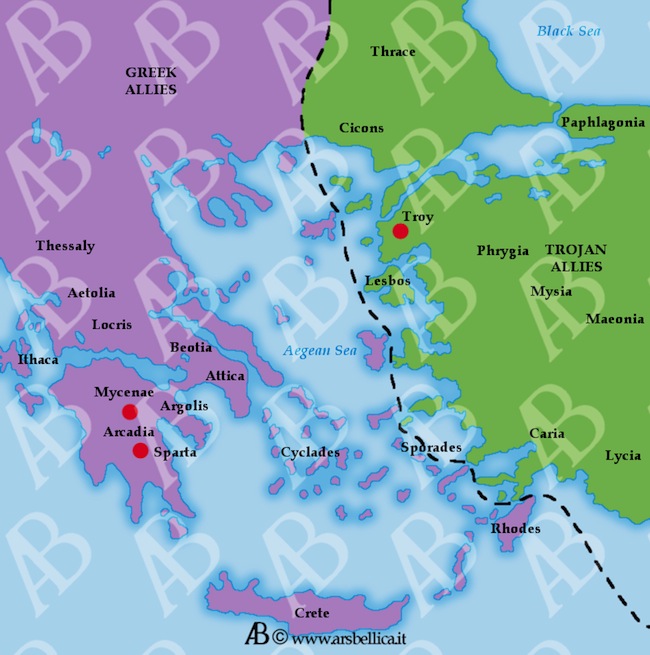
Beyond the beauty of myth, then, the Iliad testifies that the Aegean attended a terrible clash of two cultures: the Western one (Mycenaean) and Eastern (Troy) for economic dominance over an area of vital importance. The result of this situation was that an advanced and flourishing civilization, as Troy, was destroyed, while one other, the Mycenaean, was so weakened that, few decades after the war, was conquered, almost passively, by Dori.
The historical reality of this clash is testimonied in a Hittite Tablet attributed to Hattusil II (1265.1235 BC) who speaks of a powerful achaean King who fought on Asian soil in the land of Seha River (Troas).
But most of the sparse archaeological evidence convinces the fact that, after the fall of Troy, cyclical recurrence with different civilizations will face off for control over the commercial crossroads of the Eastern Aegean. Only with the circumnavigation of Africa business interests on this area will be reduced.
In conclusion, the "Trojan war" represents the first clash between Europe and Asia, which will resurface in different epochs and civilizations, but always with the same result, the West winner.
TROJAN WAR
Recent studies have highlighted some coincidences among the Atlantis described by Plato, the mythical lost land in the flames generated by a cataclysm, and the Troy of Homer. In fact, thermal sources were present both in Troy as in the "submerged continent", as well as other elements in common were the position close to the sea, the two rivers, the monumental scaean gates, the ending fire and more.
Few clues and circumstances, however, could generate a working hypothesis not entirely unfounded, that, if proven, would give new impetus to the theory that the "sea peoples", appeared in the Mediterranean scene during that time, are refugees of the Troad and Lidia, in search of new lands. In Egypt, they would have left traces of their origin on a stele. The narrative contained in the same stele, would eventually come to Plato who translated and, assuming this is much older (common misconception at the time with whatever came from Egypt), he unknowingly "copied" and revived Troy with the appearance of Atlantis.
TROJAN WAR
The middle of the thirteenth century BC, when we can date, with a certain approximation, the siege of Ilio, the art of war was moving its first steps. The armies did not have encoded tactics, or siege engines, had not yet assumed the classic lineup with a center and two wings, and chariots of Kings and most illustrious warriors were not used consistently as maneuvering mass break-out, fighting or confused with the infantry. The conduct of the war, then in the Iliad appears as a primitive level achieved by the Hittites and Assyrians, where chariots were engaged in mass as a impact force, while the infantry was well organized into divisions.
In addition, we are at the end of the bronze age, and iron is still little known or poorly used, because of exceptional costs due to its rarity. The weapons described by Homer are, except for the rare times, all in bronze and so heavy, impractical and not at all easy to handle.
Particularly interesting, enough to note in the poem, is the absence of cavalry. The horse, introduced first in the Middle East and in the West and in Egypt, was used only as mean of locomotion of the chariot, hàrma in Greek. The chariot of Mycenaean type, rather brittle, consisted of three parts: a small wooden platform, a breastwork of trellis or leather, two wheels in Elm wood with bronze circle and a rudder that connected the vehicle to the yoke of horses. The chariot crew was formed by the warrior carried, hippòdamos, and a auriga-squire, called harmelàtes. This one held the reins and ride the vehicle, while the other could fight on board handling spears, though often he get down from bandwagon to confront opponents in duels (often between aristocrats) that could decide the entire battle. The use of the chariot as we said was completely separate and left to the initiative of the noble, without any coordination with the infantry or the other wagons.
The only difference that Homer notes between the sides of the Achaeans and Trojans, lies in the fact that the first, advanced in dense formations (the so-called "phalanx"), while the second was in a sort of messy and unfocused formation. However, we do not know if this is due to a kind of "nationalism" of the author, intended to demonstrate the superior discipline of the Mycenaeans compared to the Asians, or if this deployments really respond to truth.
What is certain is that, in the centuries to which is related the Iliad, in the cities of Greece were present the first hoplitic militias. They ordered in close ranks in battle, though less dense than the future phalanx, and moved silently, for the need to hear the maneuver orders from the officers and to keep pace. Few historical records instead emerge on legendary Myrmidons chosen achaeus unit, commanded personally by brave Achilles.
1The Hoplites were soldiers (unique in their army) equipped with heavy armor.
TROJAN WAR
The achaean army was probably conducted according to Mycenaean usage: at the head of every contingent of the expedition was the wanax (sovereign) with its local lawòi representing the land Warrior nobility and of the country of origin that commanded the warriors they had led.
It was not therefore a compact structure nor a disciplined army and framed in a precise chain of command, but an accumulation of hosts who followed their Lord in battle according to a bond of loyalty. One example is the famous episode of the wrath of Achilles: once retired his King, the entire contingent of Myrmidons follows him and refrains from fighting.
The Trojan army, like that Achaeus, consisted of more peoples, each under the command of a nobleman. In some parts of the Iliad though there is a not unimportant difference between the two armies: some of contingents commanded by Trojans, seem to consist of real "seasonal" mercenaries, with a "forward contract".
The weapons of the warriors had to be very different and varied, considering the large number of people participating in the war.
Only the nobles and the Kings could equip themselves with a full armour in bronze. Most of the fighters wore probably leather or flax armour, called linothòrakes, felt or bronze greaves, knemìdes, and leather helmets (rarely bronze), kòrytes, more or less worked and reinforced with metal or floppies with boar's tusks. The finest ones can be equipped with and cheeckpieces1, made more impressive by a crest of horse-hair. According to Homer, some peoples like the Thracians, Tojans allies, not carried any helmet and were distinguished for a hair-styling, particularly related to tuft on the top of the head.
Shields, sakèa, could be of different shapes: towered, rounded or crescent. It consisted of a leather framework cooked in alum, reinforced by studs and bronze parts. Maybe there were totally metal shields, but considering the great weight of bronze, should be very small. It witnessed the use of embellish the shields with plaques of silver and gold, which had no other function than to demonstrate the opulence and richness of the owner.
The preferred weapon of offense appears to be the spear, ènchos, dòry, which was used in close clash or throwned like a Javelin. The sword, xìphos, phàsganon, was of different shapes depending on the people. The achaeans used a straight blade of various lengths and tapered towards the handle; among Asians should be shared a wide Blade model and the axe.
Were also used the bows, tòxa, and slingshots, sphendònai, used by both armies but with prevalence by the Trojans. Particularly appreciated were the Cretan bows, consisting of two-horned animals held together by a ring of bronze. In the excavations of Ilium were found numerous terracotta spheres, likely bullets for slings, used with the normal rounded pebbles of rivers. The fact that Homer attributes to the Trojans a sort of skirmish formation is justified by the prevalence of the archers in their ranks, since the use of the bow demanded a greater space between the ranks of fighters.
1The Cheekpieces are facial side shields.
TROJAN WAR
The protagonists of the ancient Greek myths are equipped with weapons and armor with divine powers: the arms of Achilles, for example, were offered by his father Peleus, who had received as a gift from Athena in occasion of his wedding with the nymph Thetis. Patroclus obtained weapons thereof by Achilles, who had deserted the battlefield to avenge Agamemnon, it is then stripped from the God Apollo, allowing Hector (Trojan hero) to kill the young Greek and to take over (and dress) of the divine armor. Achilles, destroyed by the death of his friend, asks rescue to his mother that, thanks to the forge of Hephaestus, covers his son with even more radiant weapons. The sight of his old weapons donated to a friend (Patroclus) increase the anger in him and accelerate the death of Hector, whose body is then harrowed in front of the walls of Troy by Achilles. Behind the "divine" weapons of Achilles, hides a not unimportant fact, indeed, probably, his weapons were among the first constructed in iron.
The legend of Greek hero is inevitably linked to his weak point: the heel. It all started at the time of his parents wedding banquet, when Eris (Greek goddess of chaos, strife and discord) threw a bone that caused many troubles. The mother of the hero (Thetis), in the purpouse of making him invulnerable, immersed in the swamp of Styx, but keeping it for a heel his invulnerability was not total. At the outbreak of war the mother hided him at the Court of Nicomedes, under a false identity with the name of Pyrrha; but the crafty Odysseus discovered the deception and Achilles was forced to leave for the war. Meanwhile, Agamemnon, Commander of the expedition, under the great pressure of Apollo returned to Crise (priestess of Apollo) his daughter Chryses, kept in slavery by the Greek King. Girl's deprived, Agamemnon took with him the slave of Achilles, Briseis, who angered by this "theft", refused to fight. But other events were incoming: his friend Patroclus (to which he had donated his weapons) was killed by Hector and so Achilles decided to get off once again on the battlefield.
His victory against Hector it's just a "happy" episode in the life of a hero haunted by bad luck. As example we can consider the story of his death: an arrow hurled by a man who had unleashed the war, Paris, will hit in his only weakness, the heel, mortally wounding him and completing the story of brave Achilles.
TROJAN WAR
The battle, according to the description left by Homer, was interpreted as a challenge among Kings or heroes of the two factions, and then the troops of privates had a very marginal role. The tide of battle (examples are Patroclus, Achilles and Hector) were in the hands of high-ranking warriors, to which Homer adds sometimes the help of deity. For sure it was a great pride undress the enemy killed in the duel of his arms, and bring the corpse behind their own lines. But behind to the honour of the victory, there was the horror of brutality to which the bodies of the enemy were subjected. There are rare cases of mutilation of bodies (as he writes the same Homer) and often, at the end of the battles, the bodies of the winners were the subject of undertakers while those of the losers were left prey to wild animals.
One thing for sure is that the Iliad is not convincing at all. As described, the clash/decisive battle was the latest in a campaign lasting ten years. But the battles, as they were understood in ancient times, were furious melees in which blood relations were more important than the organization and discipline, so were designed to resolve with huge losses from all fronts. So it is very unlikely the thesis of ten years of battles.
It would definitely be more logical to say that ten years have passed between ambushes, raids, sieges and political stratagems cyclically developed over several years (in this case 10). According to this thesis, the assailant Greek drove ships and troops for an expedition, then, once landed, temporary encampments and fortifications were builted near the rivers ensuring water for the warriors. At this point the invaders could dedicate to other "interests": rapid raids with which procured herds, slaves and seed, stocked to be used for the winter; the ship sacks which allowed to supply of goods carried by sea; and finally with astute infiltrations they secured information and sometimes even alliances. When the position became powerful enough and had obtained enough information on the enemy invasors could send loot to the homeland and receive the reinforcements to attempt an attack.
Considering this "siege tactics", the local element would have to react with great promptness and face the enemy, before it acquired too much power. Otherwise the aggressor, in a few years, would increase its military power, economic and political enough to supplant the local forcing them in cramped spaces up to subdue. The reaction of Troy was not sweet: defeatism and disappointment were emerged over and over again in the Greek commanders and troops; so much that the achaeans would return home if it wasn't for the crafty Odysseus's intervention with his formidable horse idea.
In regard to this last topic, what really was the famous Trojan horse (and what really Elena represented) remains a mystery which has not yet given a reply.
TROJAN WAR
The plain described by Homer is crossed by two rivers, the Simoeis and the Scamander. The two rivers meet each other and drain into the sea on the right side of the Greek camp.
The Greek camp is protected by a moat and a wall; while the ships are pulled in dry, sorted on three lines and branches from the tents. The tent of Achilles is situated at the extreme left of the Greek camp at the furthest point from the mouth of the river and therefore less protected from the ground.
Troy is located in the distance. At its sides the beds of the rivers, while the plain in front of tombs is full of characters such as Ilo the founder, or the first Queen of the Amazons, who according to legend a few years earlier had spoken in favor of Troy.
In the Iliad, it is said that there were a series of fighting interspersed with prayers, councils of war, night patrols, duels, and so on.
Here are the main stages of the battle:
The armies deployed to be drawn together beneath the walls of Troy. At first glance, the Greeks, without Achilles, that decided not to participate at the battle (as we said before), will begin to retreat towards the river Scamander pursued by Hector.
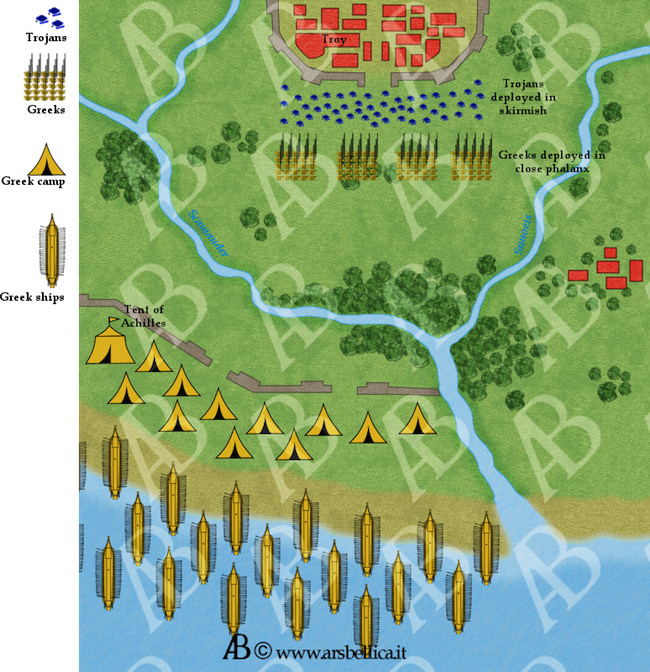
Greeks continue to retreat pursued by Trojans, until they try the clash near the wall erected by themselves as a defense for the camp and ships. The Trojans, riorganized into five ranks (the primary deployment was in a sort of skirmish), were taking over and crossed the wall, breaking up the ships of the invaders.
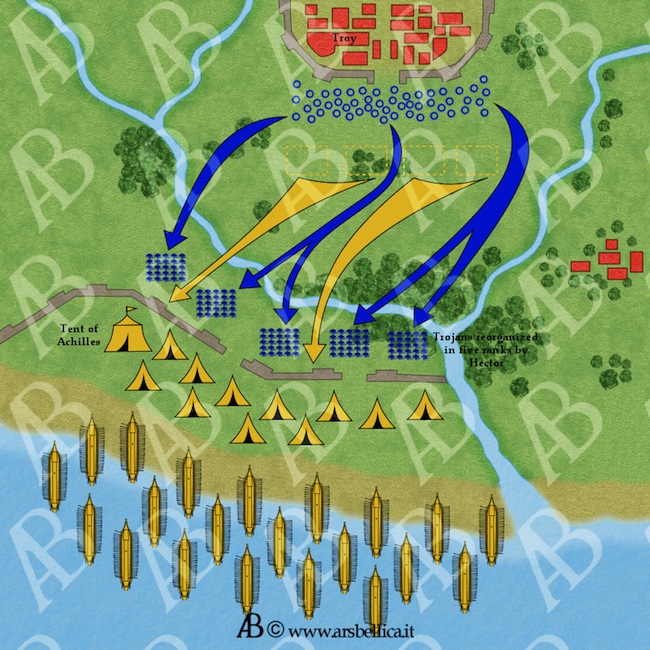
This creates a scrum in front of the ships. The Greek press on the left side of Trojans but Hector with the help of Apollo, broke from the right. Once organized the counteroffensive, he managed to bring the fight to the ships.
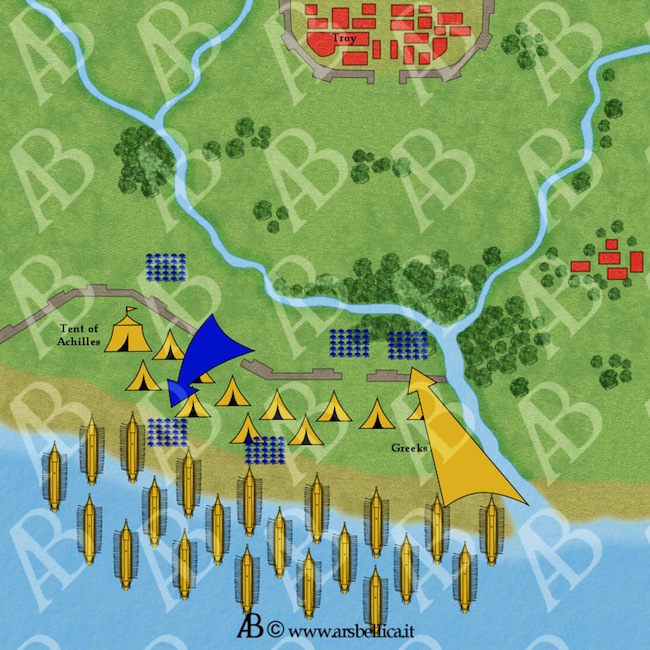
Patroclus, dressed of the arms of Achilles, comes to the aid of the Greeks almost overwhelmed. The Trojans believing he was Achilles, deceived by weapons, escaped chased by achaeans beneath the walls of Troy. In the new scrum, Hector killed Patroclus and dresses of arms that were of Achilles. The Greeks retire back to the Scamander pursued by Hector. Achilles, advised of the death of his friend, intervened in battle, his anger is overwhelming and the Trojans are soon forced to wade the river just crossed. The spirit of the river, meanwhile disgusted by the blood shed by the Trojans due to Achilles, causes a flood which slows the Greek advance, allowing the Trojans to withdraw within the walls.
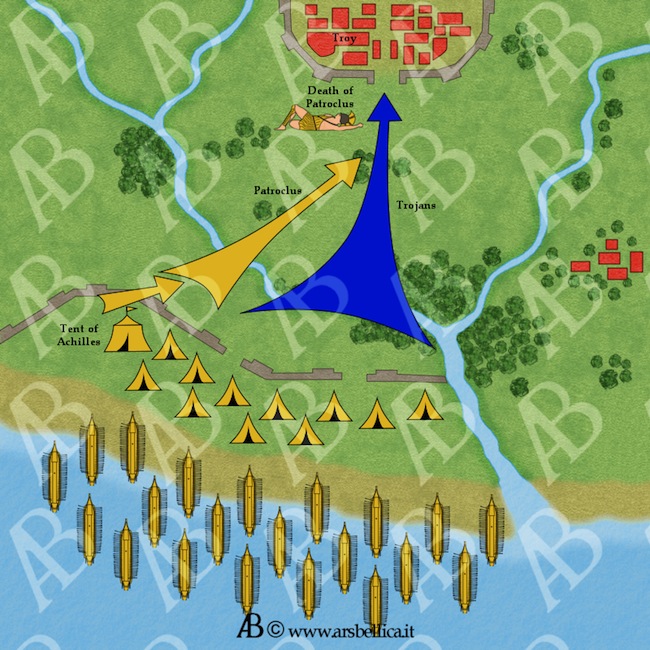
The only one who will remain outside will be Hector, he loses the duel with Achilles and his body will be subject to destruction by the Greek hero.
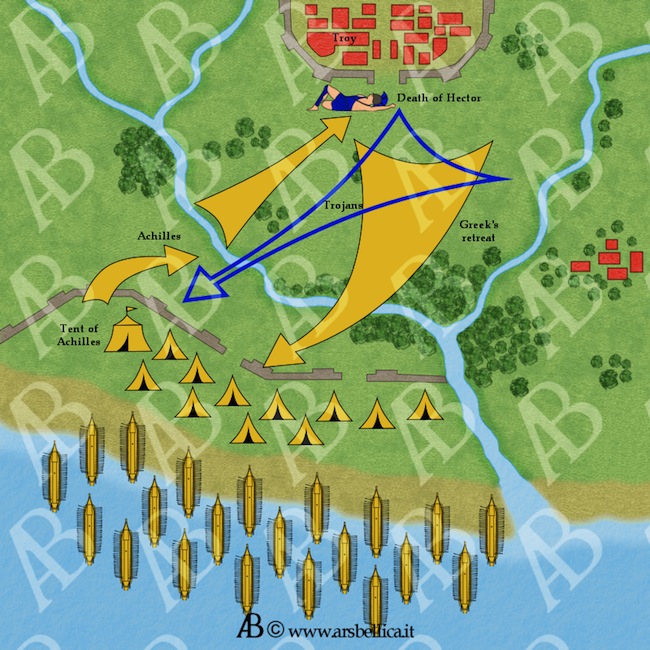
TROJAN WAR
The Iliad will conculde with the return of the Hector's corpse by Achilles to his father Priam; will be later legends that tell us of the death of Achilles, but especially the destruction of Troy by the Greeks through the horse's ploy devised by Odysseus, who opened the city gates to let the invaders plunder and the subsequent destruction of the city-fortress.
But at this end will be connected other great works of the ancient literature like the coming back home of Ulysses, the Odyssey, or the escape of Aeneas in a new home (to which trace the origins of Rome), the Aeneid, or the story of Agamemnon, who was murdered by his wife Clytemnestra and her lover Aegisthus and the subsequent revenge of the King's son Orestes, which inspired one of the greatest tragedies of the Athenian Theatre: the trilogy of the Oresteia.
TROJAN WAR
Schliemann, born to a humble family, succeeded, with the efforts of a lifetime, to put aside a substantial fortune and begin to realize the dream that he kept since a very young age: to revive the heroes of Homer. Actually was not the first to realize that the excavations had to be carried out on the Hill of Hissarlik in the present-day Western Turkish coast. The idea that on that Hill, in the middle of the flood plain of the river Scamander and Simoenta, lie the ancient Ilio, wasn't a news. The walls founded on the first layer dating back to 3000 BC, while the other layers were accumulated for fifteen centuries without major changes. In 1880 Schliemann was convinced he had found the real Troy, but was actually only the third layer: thanks to the aid of a professional archaeologist, Dorpfeld, the excavations continued.
After the death of the Schliemann, in 1890, Dorpfeld continued excavations alone to find the fortifications of Troy VI. But it is only through the intervention of the University of Cincinnati, Blegen, Caschey and Semple that today we can give a story and a dating to the Hill:
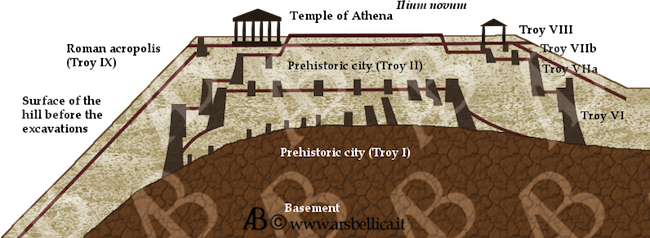
Bibliography:
Livio Agostini, Piero Pastoretto, Le grandi Battaglie della Storia, Viviani Editore, Il Giornale, 1999